Abstract
In order to reduce the environmental pollution near the port and save the cost of power supply, it is necessary to use shore power technology to power the ships that dock. This paper studies a power distribution strategy based on hybrid energy supply system. Through the establishment of wind power generation subsystem, photovoltaic power generation subsystem, and then combined with the national grid system to form a hybrid energy onshore power supply system, using the hybrid energy power supply system to power the ship. Without considering the power connection device, the whole shore power system was gridding processing. The objective function is established with the lowest cost of power supply system, and the grid node coefficient is calculated with different optimization algorithms to realize power distribution of port shore power supply system. The results showed that the power supply cost of the hybrid power supply system obtained by genetic algorithm (GA) and particle swarm optimization algorithm (PSO) is lower than the traditional power supply cost, and the power distribution is realized according to the distribution node coefficient. It provides a theoretical basis and application reference for the optimization scheme of energy management combined with port power and distributed power supply and the construction and management of new shore power.
1. Introduction
In recent years, with the development of the national economy, the requirements for rapidity in transportation are becoming higher and higher, which has made mad the construction of ports more rapid. The increasing number of ships berthed in ports has also brought challenges to the operation and management of ports. During the berthing period of a ship, in order to ensure the working operation of the ship, and the basic living requirements of the ship personnel, it is necessary to supply power. Generally, power is supplied in two ways: (1) through the ship’s own fuel power generation, which produces industrial waste gas, and causes serious pollution to the port and the surrounding environment; and (2) through the port supplying electricity to berthing ships, which is called shore power technology [1]. Shore power technology can not only reduce environmental pollution, but also save the cost of ships shoring [2]. Due to the economy and environmental protection provided by shore power technology, it is widely promoted. At present, the traditional power supply of shore power technology is the national power grid, and the search for a renewable energy power supply system for ship power supply can further save costs and protect the environment, which is of great significance to sustainable development [3]. Therefore, it is the hotspot of shore power research.
Shore power technology has been widely used at home and abroad. Many ports have achieved a shore power configuration, such as Gothenburg, the first to adopt shore power technology; Los Angeles in the United States; and Shanghai, China etc., [4]. Shore power technology is usually used at low voltages, but with the development of technology, it can now be used at high voltages as well. Therefore, it is possible to supply power to many large docked ships, and this power supply system can typically provide up to 1 MW [5,6] of power. The current research direction of shore power technology is mainly from the following aspects: conversion of onshore multi-port inverter [4], analysis of security problems in connection of high-voltage shore power technology [5], shore-ship synchronization strategy [7], and optimization of installation and operation strategy of shore power supply system [8]. However, there is little research on the optimization of wind–solar power generation systems connected to shore power supply systems, and the cleanliness of renewable energy makes the value of this aspect of research extremely high. Wind–solar power generation systems are combined with the national grid to form a new power supply mode with a wide range of applications. However, methods of adding a wind–solar power supply mode to a shore power system so that it can efficiently supply power to a docked ship have not yet been studied.
At present, most o studies on the combination of distributed power supply and power grid are focused in the field of micro-grids. Through the establishment of a micro-grid, a wind power generation system and photovoltaic power generation system are combined to supply power to the target. Some scholars have studied the hybrid renewable rural electrification system [9], making use of the abundant renewable resources in rural areas, considering the economic factors and environmental pollution parameters to study rural electrification systems, and concluded that a hybrid rural electrification system is the most favorable choice. The research on port micro-grids mainly focuses on load forecasting technology, energy management, and scheduling optimization technology of the micro-grid. In load forecasting technology, commonly used load forecasting methods can be divided into mathematical statistics methods and intelligent forecasting methods [10]. Different load forecasting methods have different effects. In micro-grid energy management and scheduling optimization technology, there are also many management and scheduling methods. In a photovoltaic micro grid energy storage system, a model for time-of-use price can be established with profit as the goal and solved by genetic algorithm [11]. Time-of-use price is more consistent with the actual price. Some scholars have adopted fuzzy logic system for scheduling with the goal of minimizing the overall model operation cost and environmental impact [12]. Some researchers have used genetic algorithms to minimize energy costs and carbon dioxide emissions [13]. The experimental results demonstrate the effectiveness of the proposed energy management system in the application of micro-grid systems. Most scholars have adopted optimization algorithms to solve the objective function. Therefore, in this paper, the load size was simulated randomly. In the established model of a wind power generation and photovoltaic power generation system, time-of-use price was adopted to minimize the cost of the hybrid energy power supply system, and a genetic algorithm and particle swarm optimization algorithm were used to optimize the target, so as to analyze the efficiency of the algorithm to a greater extent.
With the rise of shore power technology, the combination of shore power technology and micro-grid distributed power supply has gradually become the focus of research. However, there are still few studies related to it, so this study adopted two new energy sources, sunlight and wind, to power the port, and adopted the maximum power tracking method [14] to ensure the maximum utilization of energy. Combined with the State grid, a hybrid energy power supply system was obtained. The load of ships at port was simulated, and the output power of each power supply electronic system was distributed by a genetic algorithm and particle swarm optimization algorithm, so as to realize the synergistic complementation of energy. With the lowest port cost as the main goal, the power supply to ships at the wharf was realized by the way of power grid distribution. The lowest-cost grid node configuration parameters were obtained under the condition of ensuring ship power consumption. According to the application of shore power technology in ports, this paper studied the energy management optimization scheme of the combination of port power and distributed power supply, so as to provide a theoretical basis and application reference for the construction and management of new shore power supply. The significance of this research is to make full use of sustainable resources to replace the power grid to transmit electric energy and supply power to docked ships. Two main points were considered: first, when there is no shore power system, ships rely on diesel and other fuels for power supply, which will cause serious pollution to the surrounding environment of the port. The establishment of shore power system can greatly alleviate the pollution; Second, the established new energy power supply system can use wind power generation, greatly reducing the cost of shore power supply. In addition, this paper also used an optimization algorithm to effectively distribute the output power of the hybrid energy power supply system. On the basis of previous work, it further reduced the power supply cost and improved the distribution efficiency of the shore power supply network.
According to the research on the concept and development status of shore power technology and new energy power supply at home and abroad, an optimization scheme was proposed for the current shore power energy scheduling problem. The sections of the article are arranged as follows:
The first part describes the development of shore power technology at home and abroad, including the research status of new energy power supply system, and describes the main content and significance of this study.
The second part establishes the mathematical model of wind power generation system and photovoltaic power generation system and describes the control algorithm of the two energy sources.
The third part establishes a hybrid energy power supply system including wind power generation and photovoltaic power generation system. Establishing objective function to optimize the operating cost of the power supply system under grid processing and establishing corresponding constraints.
The fourth part briefly introduces the optimization algorithm, genetic algorithm, and particle swarm optimization algorithm to solve the objective function. The operation costs with the hybrid energy power supply system and without the hybrid energy power supply system were obtained, and the efficiency of the two optimization algorithms was compared to verify the correctness and feasibility of the algorithm.
Finally, this paper summarized the research content and research results.
2. Hybrid Energy Supply Systems
2.1. Wind Energy System
The hybrid energy power supply system was mainly composed of a wind power generation and photovoltaic power generation system, combined with the national grid. In this section, the model of the wind power generation system is established. In order to make the wind energy system closer to the actual system, the widely used four-component model [15] is used to represent the wind speed. The most important part of the whole wind power generation system is the wind turbine. The wind energy originally obtained by the wind turbine cannot be fully utilized and will be lost in the conversion process. The wind energy truly obtained by the wind turbine is [8]:
where
- : Output power of wind turbine (W)
- : Air density ()
- : Blade radius (m)
- : Wind speed on the wind turbine blade ()
- : Wind energy utilization coefficient of wind turbine
After the capture of wind energy, it is also necessary to convert the aerodynamic torque obtained by the transmission gear device into the mechanical torque required for the generator to work, and then output the required electrical energy through the generator. In the process, the maximum power tracking method is used to keep the wind power generation system at the maximum output power, ensuring stable output to achieve maximum resource utilization. In this study, the perturbation and observation method [16] is used to search the maximum power point with step length in the early stage until stable output is achieved.
2.2. Photovoltaic Power Generation System
In photovoltaic power generation systems, the photovoltaic array is the most important part, its role is to convert light energy into electricity.
The output characteristics of photovoltaic array are affected by multiple factors, including illumination intensity, surface temperature of photovoltaic array, the materials of the photovoltaic array, and so on. Typical photovoltaic (PV) cell models are divided into single-diode models and multi-diode models [17]. In order to simplify the calculation, the single-diode model is usually used, and the volt-ampere characteristics of typical photovoltaic arrays can be expressed by the following formula [18]:
And engineering photovoltaic mathematical models are generally used instead of [19]:
Which:
where
- : Short circuit current (A)
- : Open circuit voltage (V)
- : Maximum power point current (A) and voltage (V)
- : Photovoltaic array temperature ()
- : Photovoltaic array reference temperature ()
- : Light radiation ()
- : Reference radiation ()
- : Temperature coefficient of current change
- : Temperature coefficient of voltage variation
- : Series resistance value of photovoltaic array ()
Due to the nonlinear output characteristics of photovoltaic cells, in order to make photovoltaic cells always work at the maximum power point, perturbation and observation method is also used for maximum power tracking. The algorithm flow chart is shown in Figure 1.
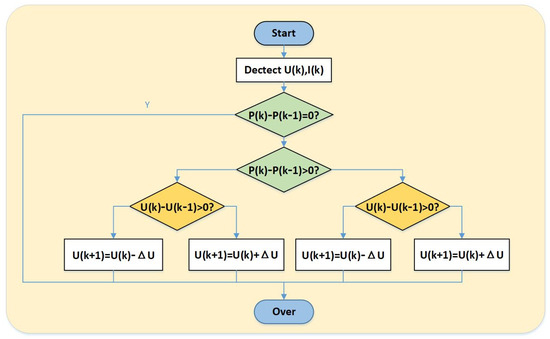
Figure 1.
The algorithm flow chart of perturbation and observation method.
3. Grid Power Allocation for Shore Power
3.1. Grid Processing of Shore Power System
In order to solve the problem of port ship load power supply, the whole system is gridded without considering the connection system and receiving system of shore power system, and the grid model can be obtained as Figure 2.
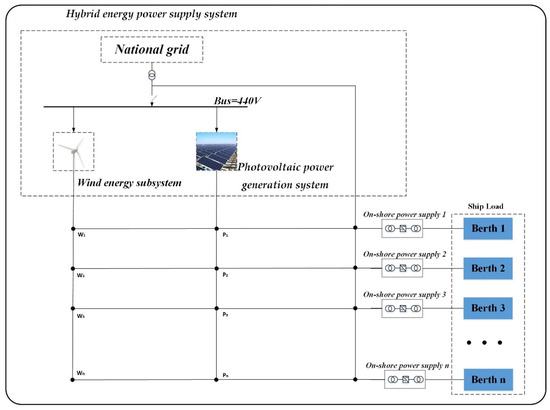
Figure 2.
Grid processing block diagram of hybrid energy power supply system.
The w node in Figure 2 is the node between the wind power generation system and the berth, node p is the node between the photovoltaic power generation system and the berth. The node coefficient determines the amount of electricity transmitted by the wind power generation system to the corresponding berth at that moment.
The wind energy system, photovoltaic power generation system and national grid system constitute a hybrid energy power supply system. The power supply system is connected to the ship load. In the hybrid energy power supply system, the output of wind power and photovoltaic power generation system is preferentially used to meet the power demand of the ship. In the case of insufficient wind power and photovoltaic power generation, the power of the grid is used to meet the remaining power supply demand of the ship.
3.2. Power Distribution Model for Gridding of Hybrid Energy Supply System
3.2.1. Model Assumptions
- (1)
- Do not consider the construction cost of hybrid energy power supply systems;
- (2)
- Assuming that the system has no transmission loss throughout the power allocation process;
- (3)
- There is no fault and interference in shore power distribution.
3.2.2. Power Distribution Model for Gridding
The hybrid energy power supply system in this study is a hybrid power supply composed of a wind power generation system, photovoltaic power generation system and main grid. The minimum system cost is taken as the objective function, and a series of constraints are considered.
Objective function: Make the total power supply cost of power supply system lowest when the port power supplies to the ship.
where
- : Total cost of power supply system (yuan)
- : Cost of wind energy system (yuan)
- : Cost of photovoltaic power generation system (yuan)
- : Cost of main grid system (yuan)
- : Output power of wind energy system at time t (kWh)
- : Output power of photovoltaic power generation at time t (kWh)
- : Output power of main grid generation at time t (kWh)
Constraint conditions:
- (1)
- The node power balance is satisfied, that is, the power required by the ship at the ith berth at time t is equal to the power provided by each generation subsystem at that moment:
- (2)
- Output power of wind and photovoltaic power generation should not exceed its power at time t:
- (3)
- Node coefficient constraint:where
- : Power of wind power generation at time t (kWh)
- : Power of photovoltaic power generation at time t (kWh)
- : Load of the ith ship at time t (kWh)
- : The node between the wind power system and the ith berth
- : The node between the photovoltaic power generation system and the ith berth
4. Results
4.1. Algorithm Description
In the grid power distribution system, the ship load at the port is dynamically changed in a period of time. In this study, genetic algorithm (GA) [20] and particle swarm optimization algorithm (PSO) are used to calculate the parameters of each grid node when the cost of port hybrid energy power supply system is the lowest, so as to achieve the economic optimal solution. The grid power allocation steps of the two optimization algorithms are shown in Figure 3.
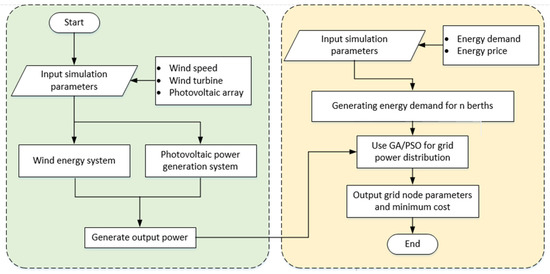
Figure 3.
The flow chart of grid power allocation.
4.2. Parameter Settings
This study takes an hour per day as a time period, the step length is 1 h, the total time is 24 h. The following focuses on wind power generation system, photovoltaic power generation system and energy price parameters.
- (1)
- Parameters of wind energy system
The parameter setting in wind power generation system is mainly the parameter setting of wind turbine. The simulation parameters are set as Table 1.

Table 1.
Simulation parameters of wind turbine.
- (2)
- Parameters of the PV system
The most important part of photovoltaic power generation system is photovoltaic array. The number of photovoltaic array determines the ability to capture light energy. Here the photovoltaic array is set to 10 groups with 8 rows and 7 columns, and the simulation parameters are set as Table 2.

Table 2.
Simulation parameters of PV system.
In the ideal case, the series resistance of photovoltaic array is almost zero [21], so it can be ignored.
- (3)
- Parameters of Energy price
According to the price of China’s industrial electricity, electricity price is divided into two kinds, a time-sharing billing [10], a pricing billing [22]. This study use time-sharing billing and the prices set as Table 3. The operating cost of wind power generation is set at 0.1 yuan/kWh, and that of photovoltaic power generation is set at 0.0096 yuan/kWh.

Table 3.
Simulation parameters of energy price.
4.3. Simulation Results of Hybrid Energy Power Supply System
4.3.1. Output Power Results of Wind Energy System
According to the above parameters, the wind speed data of 24 h a day can be obtained. The hourly distribution characteristics of wind speed can be obtained by processing the wind speed data, as shown in Figure 4. Visible wind speed is concentrated in 4–7 m/s, the average wind speed is 6.3457 m/s.
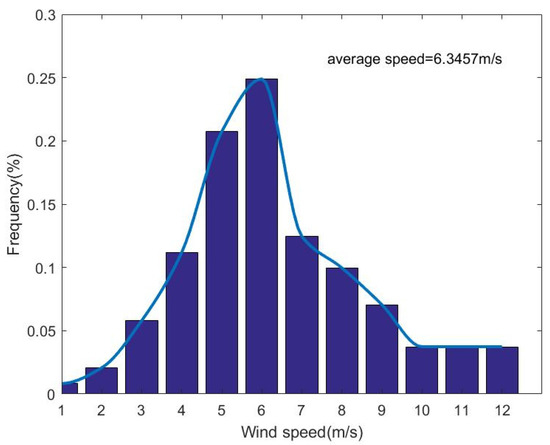
Figure 4.
Hourly distribution characteristics of wind speed.
The output power of the wind power generation system can be obtained by inputting the obtained wind speed into the wind power generation system as shown in Figure 5. Figure 5a is the input wind speed, Figure 5b is the output power of wind power generation system after the input wind speed. It can be seen that the output power of the wind power generation system is related to the input wind speed. In the area of large wind speed, the output power is also relatively large.
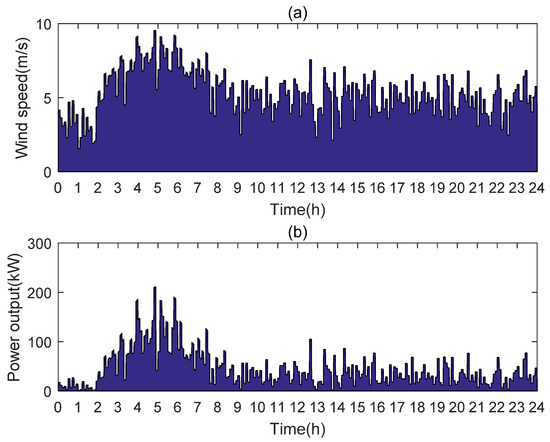
Figure 5.
(a) wind speed; and (b) output power of wind power generation system.
4.3.2. Output Power Results of Photovoltaic Power Generation System
For photovoltaic power generation system, it is necessary to determine the input light and temperature. The output power of the photovoltaic power generation system can be obtained by inputting light and temperature into the photovoltaic array as shown in Figure 6. It can be seen from the figure that the output power of photovoltaic power generation system is concentrated in the day when there is light.
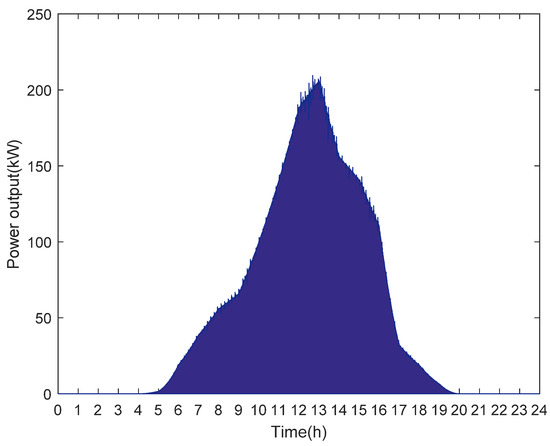
Figure 6.
Output power of the photovoltaic power generation system.
4.4. Results of Grid Node Parameters
4.4.1. Ship Shore Power Load Simulation Results
Since the ship load and the number of ships on the shore of the port change in real time within 24 h of a day, it is necessary to simulate the energy demand of the ship shore before the grid power distribution is carried out, and then the power supply cost can be calculated. In this study, the energy demand of ship shore power in a berth is simulated in the range of 100–1000 KWh, and the energy demand of ship shore power in a berth is shown in Figure 7.
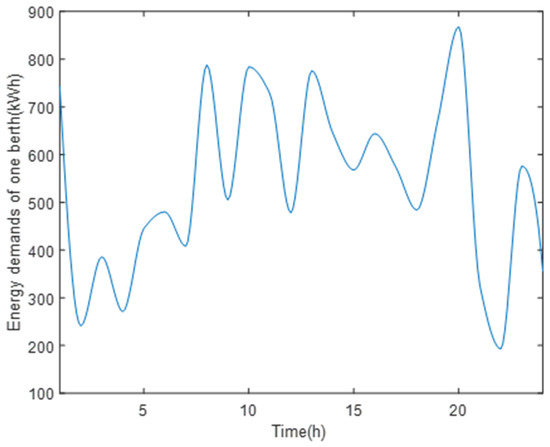
Figure 7.
Energy demand of ship shore power in a berth.
4.4.2. Parameter Results of Grid Nodes Using Time-Sharing Billing
Set the simulation time to 24 h and 5 port berths. The cost of hybrid power supply system calculated by genetic algorithm is 41,963.84 yuan. The corresponding grid node parameters are shown in Table 4, and the energy and power distribution results of each berth are shown in Figure 8. The mixed energy power supply cost calculated by particle swarm optimization algorithm is also 41,963.84 yuan, and the corresponding grid node parameters are shown in Table 5. In order to prove that the power supply cost can be effectively controlled after the addition of hybrid energy power supply system, this paper calculates the power supply cost of traditional shore power. The power supply cost of traditional shore power is the generation cost of using grid power supply. The price of 24 h a day is shown in Table 3. After calculation, the cost of the traditional power supply system is 43,042.15 yuan, which shows that the hybrid energy system is more cost-saving than the traditional power supply system, and the results obtained by the two optimization algorithms are almost the same.

Table 4.
Corresponding grid node parameters of berth in time-sharing billing by GA.
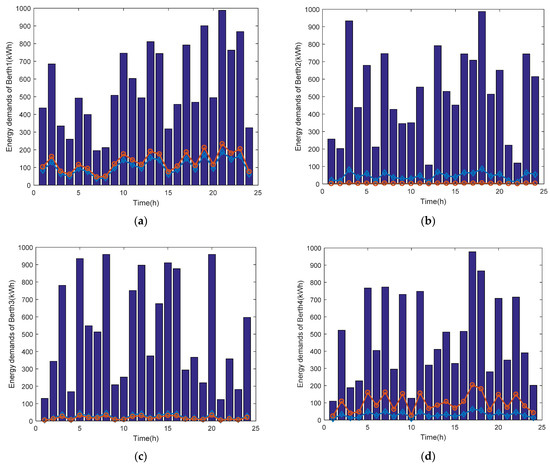
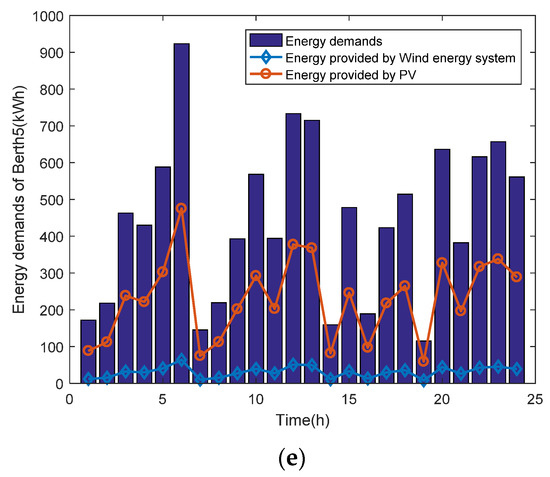
Figure 8.
Energy power distribution results of time segment billing: (a) berth 1; (b) berth 2; (c) berth 3; (d) berth 4; and (e) berth 5.

Table 5.
Corresponding grid node parameters of berth in time-sharing billing by PSO.
The above situation is the power distribution of the five berths. Table 6 shows the comparison of power supply costs between hybrid power supply system and traditional grid using different algorithms under different berth numbers. As can be seen from Table 6, the cost of the hybrid power supply system is always lower than that of the traditional power supply system, regardless of the number of berths.

Table 6.
Cost comparison of two different power supply methods in time-sharing billing.
As can be seen from Table 6, the power supply costs obtained by genetic algorithm and particle swarm optimization algorithm are almost the same, with minimal difference. In order to compare the advantages and disadvantages of the two algorithms, this study calculates the running time of the two algorithms under the same number of iterations and the same MATLAB version. The running time of the two algorithms is shown in Table 7. As can be seen from Table 7, the running efficiency of genetic algorithm is much faster and has better effect in comparison.

Table 7.
The running time of the two algorithms. (unit: s).
In order to further verify the effect of energy change, consider adding a single new energy generation. When there is only a single new energy power generation system, GA is used to obtain the power supply cost of time-sharing billing, as shown in the Figure 9. When a single new energy power generation system functions, the power supply cost is higher than that of the hybrid energy power supply system, and it can be seen that the power supply cost of a single photovoltaic power generation system is slightly lower than that of a single wind power generation system.
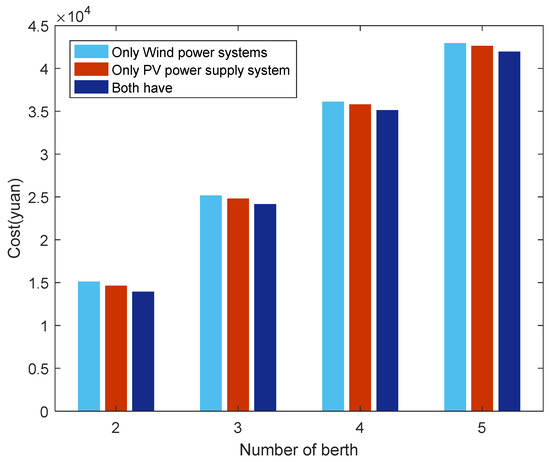
Figure 9.
The cost of power supply when the power supply energy changes.
5. Conclusions
This study introduced a power distribution optimization problem based on a hybrid energy supply system. A hybrid onshore power supply system combining wind power generation subsystem, PV power generation subsystem and national grid was established. The output power of each subsystem of the hybrid energy power supply system was obtained by using the simulation model, and the grid node coefficient when the power supply cost is the lowest was calculated by a genetic algorithm (GA) and particle swarm optimization algorithm (PSO) to realize the power distribution of the port ashore power supply system:
- (1)
- A hybrid energy power supply system was established, and the output power of each subsystem was obtained;
- (2)
- Using a genetic algorithm and particle swarm optimization algorithm to solve the objective function, the grid node coefficient when the cost of the power supply system is the lowest was obtained, and the power was allocated according to the grid node coefficient. Compared with the traditional power supply system, the cost of the hybrid energy supply system is lower, which has a certain reference significance for the actual port ship shore power distribution.
At present, there are few studies on adding renewable energy power supply systems in onshore power systems. In the literature [23], the problem of shore power allocation has been put forward, but wind power systems and photovoltaic power systems were not introduced to jointly generate an energy power supply system for shore power supply. However, the scheme adopted in the literature [8] added a renewable energy system, but did not use a genetic algorithm or particle swarm optimization algorithm for optimization comparison at the same time. In this paper, a genetic algorithm and particle swarm optimization algorithm were used to allocate power, respectively, to realize the allocation of shore power supply network, which lays a foundation for the establishment of an efficient and energy-saving shore power supply platform in the future. Compared with the methods proposed in the above literature, this paper used two optimization algorithms to verify the effectiveness of the model and compared the operation efficiency of the two algorithms to clarify the high efficiency of the genetic algorithm in the optimization scheduling of onshore power.
The hybrid energy power supply system established in this paper can make full use of the port wind and light resources and reduce the power supply cost as much as possible while ensuring the shore power supply. In addition, the power supply network of the port was preliminarily built, and the power distribution was effectively carried out by using different optimization algorithms to realize the allocation of shore power supply network, laying a foundation for the establishment of an efficient and energy-saving shore power supply platform in the future.
Author Contributions
Conceptualization, D.X. and J.H.; methodology, D.X.; software, J.H.; writing—original draft preparation, J.H.; writing—review and editing, D.X. and J.H.; supervision, F.C. and Z.D.; project administration, Z.Y. and C.L. All authors have read and agreed to the published version of the manuscript.
Funding
This research was funded by the Science and Technology Project of State Grid Corporation of China, grant number 52094021N00R.
Institutional Review Board Statement
The studies did not involve humans or animals.
Informed Consent Statement
The studies did not involve humans or animals.
Data Availability Statement
Not applicable.
Conflicts of Interest
The authors declare no conflict of interest.
References
- Song, Y.Q.; Xiao, L.M. Technology of Uninterruptable Shore-side Power Supply for Berthing Vessels and Its Application. In Proceedings of the 3rd International Conference on Advances in Energy & Environmental Science, Zhuhai, China, 25–26 July 2015. [Google Scholar]
- Cao, D.; Ma, Z.; Zheng, W.; Xu, K.; Ma, Z.; Song, C. Research on Energy Efficiency Economy and Environmental Benefit Evaluation Method of Ship Shore Electricity Technology. In Proceedings of the 4th International Conference on Information Science & Control Engineering, Changsha, China, 21–23 July 2017. [Google Scholar]
- Kumar, J.; Kumpulainen, L.; Kauhaniemi, K. Technical design aspects of harbour area grid for shore to ship power: State of the art and future solutions. Int. J. Electr. Power Energy Syst. 2019, 104, 840–852. [Google Scholar] [CrossRef]
- Xu, F.; Lu, Y.; Xuan, X.; Qiu, P.; Tong, K.; Xuan, J.; Chen, Q.; Jiang, D. Research on flexible medium-voltage DC distribution technology based shore-to-ship power supply system. In Proceedings of the IECON 2017—43rd Annual Conference of the IEEE Industrial Electronics Society, Beijing, China, 29 October–1 November 2017. [Google Scholar]
- Sulligoi, G.; Bosich, D.; Pelaschiar, R.; Lipardi, G.; Tosato, F. Shore-to-ship power. Proc. IEEE 2015, 103, 2381–2400. [Google Scholar] [CrossRef]
- Peterson, K.L.; Chavdarian, P.; Islam, M.; Cayanan, C. Tackling ship pollution from the shore. IEEE Ind. Appl. Mag. 2008, 15, 56–60. [Google Scholar] [CrossRef]
- Smolenski, R.; Benysek, G.; Malinowski, M.; Sedlak, M.; Stynski, S.; Jasinski, M. Ship-to-shore vs. shore-to-ship synchronization strategy. IEEE Trans. Energy Convers. 2018, 33, 1787–1796. [Google Scholar] [CrossRef]
- Li, X.; Peng, Y.; Wang, W.; Huang, J.; Liu, H.; Song, X.; Bing, X. A method for optimizing installation capacity and operation strategy of a hybrid renewable energy system with offshore wind energy for a green container terminal. Ocean Eng. 2019, 186, 106125. [Google Scholar] [CrossRef]
- Krishnamoorthy, M.; Periyanayagam, A.D.; Santhan Kumar, C.; Praveen Kumar, B.; Srinivasan, S.; Kathiravan, P. Optimal sizing, selection, and techno-economic analysis of battery storage for pv/bg-based hybrid rural electrification system. IETE J. Res. 2020, 1–16. [Google Scholar] [CrossRef]
- Wang, J. Port of the Micro Grid Electricity Load Forecasting and Scheduling Optimization Key Technology Research. Doctoral Dissertation, Wuhan University of Technology, Wuhan, China, 2020. (In Chinese). [Google Scholar]
- Zhou, N.; Fan, W.; Liu, N.; Lin, X.; Zhang, J.; Lei, J. Multi-objective capacity optimization allocation of photovoltaic microgrid energy storage system based on demand response. Power Grid Technol. 2016, 40, 8. (In Chinese) [Google Scholar]
- Chaouachi, A.; Kamel, R.M.; Andoulsi, R.; Nagasaka, K. Multiobjective intelligent energy management for a microgrid. IEEE Trans. Ind. Electron. 2012, 60, 1688–1699. [Google Scholar] [CrossRef]
- Elsied, M.; Oukaour, A.; Youssef, T.; Gualous, H.; Mohammed, O. An advanced real time energy management systemfor microgrids. Energy 2016, 114, 742–752. [Google Scholar] [CrossRef]
- Ahmed, N.A.; Miyatake, M. A Stand-Alone Hybrid Generation System Combining Solar Photovoltiac and Wind Turbine with Simple Maximum Power Point Tracking. In Proceedings of the 2006 CES/IEEE 5th International Power Electronics and Motion Control Conference, Shanghai, China, 14–16 August 2006; Volume 37, pp. 1–7. [Google Scholar]
- Xu, W.; Li, T. Modeling and Simulation of Typical Wind Conditions in Wind Farm Based on MATLAB/Simulink. Jilin Electr. Power 2014, 42, 16–19. (In Chinese) [Google Scholar]
- Xu, S.W.; Dong, Y.; Zhang, Y.; Li, L.F.; Zeng, J.Y.; Cai, H.W. Photovoltaic power maximum power point tracking technology based on the fractional-step perturbation observation method. In Proceedings of the 4th International Conference on Information Technology & Management Innovation, Shenzhen, China, 12–13 September 2015; Atlantis Press: Shenzhen, China, 2015. [Google Scholar]
- Vankadara, S.K.; Chatterjee, S.; Balachandran, P.K. An accurate analytical modeling of solar photovoltaic system considering rs and rsh under partial shaded condition. Int. J. Syst. Assur. Eng. Manag. 2022, 13, 2472–2481. [Google Scholar] [CrossRef]
- Ren, J.; Li, C.; Yun, T.; Xia, Y.; Yao, S. Modeling of Photovoltaic Grid Connected Generation System Based on Parameter Identification Method. In Proceedings of the 2016 International Conference on Smart City and Systems Engineering (ICSCSE), Zhangjiajie, China, 25–26 November 2016. [Google Scholar]
- Meng, D.; Liu, W.; Cui, M. Coordinated control strategy and grid connection of wind-wind complementary power generation system. J. Hebei Inst. Water Resour. Electr. Power 2021, 31, 6. (In Chinese) [Google Scholar]
- Chahar, V.; Katoch, S.; Chauhan, S.S. A review on genetic algorithm: Past, present, and future. Multimed. Tools Appl. 2021, 80, 8091–8126. [Google Scholar]
- Wang, T. Research on Control Strategy of Wind-Wind Complementary Power Generation System; Anhui University of Science and Technology: Huainan, China, 2019. (In Chinese) [Google Scholar]
- Wang, W.; Peng, Y.; Li, X.; Qi, Q.; Feng, P.; Zhang, Y. A two-stage framework for the optimal design of a hybrid renewable energy system for port application. Ocean Eng. 2019, 191, 106555. [Google Scholar] [CrossRef]
- Peng, Y.; Li, X.; Wang, W.; Wei, Z.; Bing, X.; Song, X. A method for determining the allocation strategy of on-shore power supply from a green container terminal perspective. Ocean Coast. Manag. 2019, 167, 158–175. [Google Scholar] [CrossRef]
Publisher’s Note: MDPI stays neutral with regard to jurisdictional claims in published maps and institutional affiliations. |
© 2022 by the authors. Licensee MDPI, Basel, Switzerland. This article is an open access article distributed under the terms and conditions of the Creative Commons Attribution (CC BY) license (https://creativecommons.org/licenses/by/4.0/).